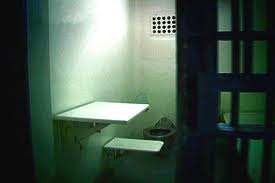April 28, 2014
Colorado has passed legislation that bans Long-Term Solitary Confinement of incarcerated individuals with serious mental illness. Individuals with “serious” or “major” mental illnesses will be moved into environments that, while still restricted, provide access to therapeutic treatment. However, many advocates for the discontinuation of solitary confinement say the bill doesn’t go far enough because “serious” or “major” mental illness can be “defined down” administratively to exclude a large number of people who may not be diagnosed with schizophrenia or bipolar disorder but who do have profound mental illness.
<http://www.leg.state.co.us/
http://www.
April 25, 2014
Several men in Administrative Detention at the Menard Correctional Center in Illinois have reported that all of the windows in the High Security Unit are being covered (blocked) with a steel covering in retaliation for their hollering out to the protestors who marched outside the facility during their recent hunger strike. And they express fear for their safety, security and wellbeing because they are being subjected to unwarranted and excessive force in front of the warden who takes no action to stop it.
http://sfbayview.com/2014/
April 24, 2014
The ACLU report, Worse than Second Class: Solitary Confinement of Women in the United States, looks at the gendered impact of solitary. It notes that: Nearly seventy-five percent of incarcerated women have been diagnosed with mental illness, a rate much higher than that of their male counterparts; the majority have reported past physical or sexual abuse; they are regularly supervised by male guards even when showering, changing clothes and using the toilet; if they complain about sexual abuse by prison staff they are often placed in solitary while their complaints are investigated, which discourages such reporting; access to prenatal care for pregnant women may be jeopardized by placement in solitary; and, transgender women in male prisons are put in solitary for “protection” but become more vulnerable to staff abuse. The report also points to the negative effects the women’s children. Recommendations for change focus on reducing the potential impact of solitary confinement.
http://solitarywatch.com/2014/
The ACLU reports on a woman who was found unfit to stand trial because of dramatic mood swings and psychosis associated with her bipolar disorder. While this meant that she should’ve been hospitalized to get the intensive mental health care she needed, she was instead placed in solitary confinement which only made her sicker. Finally, the charges against her for two minor instances of domestic violence were dropped, and she got to go home to her family.
https://www.aclu.org/blog/
April 24 & 25
One of the four main SHU reps at Pelican Bay State Prison reports some improvements in the condition of the men there which have resulted from their negotiations with the authorities including: three-hour visits; being allowed to possess a lot more personal property items; promised re-instatement of the loaner recreational book program; and expanded canteen items lists, including electronic accessories. He notes that, “all prisoners’ efforts have not been in vain.” But he and another rep also expresses serious criticism of the Security Threat Group-Step Down Program (STG-SDP), which is supposed to enable men to get out of SHU, because it is not essentially behavior based, it still relies on informant information and it potentially creates a revolving door. They fear it will not bring any real change. So they say they are relying on the legislature to rein in the CDCR’s “gross abuse of power.”
http://sfbayview.com/2014/
http://sfbayview.com/2014/we-
April 22, 2014
PBS aired its investigative report, “Solitary Nation,” which examines the use and impact of solitary confinement.
http://www.pbs.org/wgbh/pages/
April 17, 2014
A transgender teenage girl has been placed in de facto solitary confinement in a Connecticut adult prison, despite the fact that she faces no criminal charges. The youth’s affidavit details a history of neglect and abuse, including sexual abuse, in her upbringing while under the custody of the Connecticut Department of Children and Families, which has been her legal guardian since age five. The DCF claims that the youth had established a pattern of assaulting staff members and fellow incarcerated persons at psychiatric and juvenile detention facilities. A rarely-used statute in the state enables the Department of Children and Families (DCF) to place juveniles in adult prisons if they prove they cannot care for the youth anywhere else.
http://thinkprogress.org/
http://www.huffingtonpost.com/
April 16, 2014
A Maine court has sent an individual with a diagnosed personality disorder back to prison from a psychiatric treatment facility after ruling that he now has “substantial capacity to appreciate [the] wrongfulness” of his behavior. Experts had testified that the man, who previously spent many years in solitary confinement, had improved but was still engaging in self-harm and manipulating hospital staff. The hearing made clear the state’s main mental hospital wanted to rid itself of patients with difficult “personality disorders” since the loss of millions of dollars in federal funding because of treatment and safety deficiencies involving aggressive patients
http://portland.thephoenix.
April 11, 2014
Several individuals accused of being part of a prison gang have waged a hunger strike to protest conditions at Honolulu’s Federal Detention Center. Their attorneys say they are protesting isolation in a segregated unit and conditions that include a lack of clean underwear, loss of family visits and maggots in food. Several of the men have pled guilty to the gang charge in the hope of getting out of segregation and possibly being transferred to stateside facilities.
http://www.greenfieldreporter.
April 10, 2014
A federal judge in Sacramento, CA called the state’s use of large amounts of pepper spray to subdue mentally ill incarcerated persons a “horrific” violation of constitutional protections against cruel and unusual punishment. He also ordered revision of policies governing how mentally individuals in the state’s prisons are disciplined, including: requiring prior approval from a doctor or clinician before a mentally ill person may be put into segregated housing; and, barring their being returned to solitary confinement if their psychiatric conditions require higher levels of care.
http://documents.latimes.com/
http://www.latimes.com/local/
April 9, 2014
A Pakistani national, who was held by US forces in Afghanistan’s Bagram prison for nine years despite being innocent of charges, says his captors held him in solitary confinement and regularly subjected him to beatings, sleep deprivation, and a sustained campaign of mental disintegration. The Justice Project Pakistan has taken the Pakistani government to court to push for the remaining detainees’ liberation ahead of the withdrawal of foreign troops by the end of 2014.
http://tribune.com.pk/story/
In a letter to former Congressman Jesse Jackson Jr., who is serving a 30 month sentence in prison and spent a brief period in solitary confinement, the Executive Director of NRCAT, points out the arbitrariness and injustices of the torture of solitary confinement and asks him to raise his voice in support of its victims.
http://www.huffingtonpost.com/
A bill drafted last summer in the wake of California’s SHU hunger strikes has passed through the Public Safety Committee by a 4-2 vote. If it becomes law, AB 1652 will sharply limit the number of offenses that can qualify someone for isolation, create a five-year maximum for time spent in the SHU, and end the practice of “gang validation.”
http://
http://inthesetimes.com/
April 9- 25 2014
According to immigrant justice activists, Tacoma detention center is continuing to retaliate against detainees that participated in a recent hunger strike by placing them in isolation. And on April 14, at least six of the hunger strikers were part of a mass deportation. The remaining hunger strikers were finally released into general population on April 25.
http://www.
April 9, 2014
Seven employees at a Taylorsville prison in North Carolina have lost their jobs in an ongoing investigation into the death of a mentally ill man who had been held in solitary confinement. Some resigned, others were fired.
http://www.wral.com/nc-prison-
A circuit court has rejected the appeal of a man in long-term administrative segregation since January 2011 in Wyoming. The judgment states that the man has no protected liberty interest, because he is not being deprived of life, liberty or property as stipulated the 14th amendment, adding that “[T]he Constitution itself does not give rise to a liberty interest in avoiding transfer to more adverse conditions of confinement.” But, after acknowledging that State policies or regulations may create a liberty interest in avoiding particular conditions of confinement when they impose atypical and significant hardship, the judges find that the conditions on his unit were “not pleasant… [but] … not extreme”, and thus did not constitute a breach of due process.
http://www.ca10.uscourts.gov/
April 8, 2014
A new report from the Treatment Advocacy Center and the National Sheriffs’ Association notes that 44 states and the District of Columbia have at least one jail that houses more people with mental illnesses than the largest state psychiatric hospital does. Failure of the mental health system has resulted in the incarceration of about 356,268 people with mental illness because they have nowhere else to go. http://thinkprogress.org/
http://www.tacreports.org/
The attorney for the Maine Department of Corrections said that there would be “real consequences” if the Maine Supreme Court does not overturn a lower court ruling that would restrict when the department places an incarcerated person in segregation. This statement came as part of an appeal filed by the state in the case of a man who has been indicted for aggravated attempted murder in connection with the beating death of another man also in prison. After that indictment the man was held in solitary confinement for two years. The lower court had ruled that an indictment, which is based on “probable cause” was insufficient and that a higher standard such as preponderance of the evidence is needed when placing an incarcerated person in segregation.
http://bangordailynews.com/
April 7, 2014
Lawyers for Shaker Aamer, the last former British resident imprisoned at Guantánamo Bay, Cuba, asked a federal judge on Monday to order his release because he has post-traumatic stress disorder, depression, anxiety, paranoia, insomnia and a number of other serious psychological problems. The psychiatrist, who examined the man, recounted his claims of beatings and other forms of torture including isolated confinement and force feeding when he was on hunger strike
http://www.nytimes.com/2014/
http://www.theguardian.com/
April 5, 2014
The warden of the New York City jail where a homeless, mentally ill veteran “baked to death” in an overheated cell in February, has been demoted and transferred to another unit that doesn’t house mentally ill persons. Other disciplinary actions involved the engineer responsible for the heating system and one of the guards. The DOC says it is taking steps to address the breakdown of inadequate procedures, staff performance, and maintenance, to ensure that tragedies such as this never happen again. But family members consider the disciplinary actions unsatisfying. And advocates for the mentally ill have said this death represents the failure of the city’s justice system to adequately respond to this population.
http://www.reviewjournal.com/
A California court denied a motion of the California Department of Corrections and Rehabilitation (“CDCR”) to terminate a 1995 decision that CDCR was in violation of the Eighth Amendment rights of incarcerated individuals with serious mental illness because it failed to meet the obligation to provide class members with access to adequate mental health care. They were ordered to remedy the gross systemic failures with the aid of a court appointed Special Master who would then monitor the plan’s implementation. In asking for the case termination, and for the Court’s judgment to be vacated, prison officials contended that they have remedied the six core constitutional deficiencies. The court disagreed.
http://www.leagle.com/
April 4 & 5, 2014
The ACLU of Washington and Columbia Legal Services filed a lawsuit in Federal District Court in Tacoma, WA seeking a temporary restraining order to prohibit ICE from retaliating against the detained immigrant hunger strikers by placing them in solitary confinement. The ACLU notes that the people on strike are engaged in First Amendment-protected activities. The strike had been initiated to express concerns with national immigration policy, especially the mass deportations, and to raise awareness about the conditions of their confinement. After the lawsuit was filed, the strikers in solitary confinement were released back into the general population.
https://aclu-wa.org/news/
https://aclu-wa.org/sites/
http://www.theguardian.com/
April 1, 2014
The British Home Secretary is again pressing the British High Court to agree to the extradition of Haroon Aswat, a British al – Qaeda suspect, to the United States. Last year, the European Court of Human Rights blocked the extradition, ruling that he should be protected against the possibility of being placed in long-term isolation because of his mental illness. The British government says that the US Department of Justice had indicated it was “highly unlikely” that Aswat would be held at the ADX “supermax” prison in Florence, Colorado, and in any event the US was a country with sophisticated medical resources and capable of taking care of his mental health needs.
http://www.telegraph.co.uk/
March 31, 2014
Noting that bills in the General Assembly in Maryland that would have required the state to conduct an independent investigation of the Department of Public Safety and Correctional Services’ use of isolated confinement died in committee before they reached the House and Senate floors, the Baltimore Sun urged lawmakers to take the issue up again next year and pass such legislation. They argue that there is a need for public scrutiny of potential violations of international norms and human rights abuses. Such scrutiny has been evaded thus far by the prison policies that talk of “segregation” or “protective custody,” never mentioning “solitary confinement.”
http://www.baltimoresun.com/
March 25, 2014
When a 6.9 earthquake struck Eureka,CA, not far from the Pelican Bay Prison, all of the caged doors were immediately double locked. One of the men incarcerated there describes feelign the earthquake, then all fearing the concrete slabs around him might collapse. He notes that the action of the prison authorities sent a clear message: “Your safety is not hardly our priority.
http://sfbayview.com/2014/





Follow the #HALTsolitary Campaign